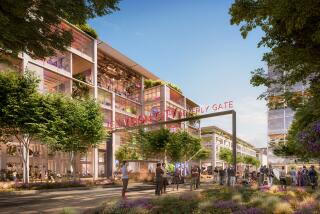Air Force Fails to Win Growth Controls : Lancaster: City Council votes to delay action on a policy that would reduce the number of new houses permitted near the military production and test plant.
- Share via
In a setback for the U.S. Air Force, the Lancaster City Council has balked at approving new limits on housing development around the military’s aircraft production and test facility at Plant 42 in the Antelope Valley.
The suggested city policy changes, the result of a yearlong study, were meant to limit the number of new residences near the plant that could be affected by jet noise or be in potential crash zones. The proposed limits were opposed by developers and real estate agents who want more building in the area.
The City Council voted 3 to 2 Monday night to delay action on the new land-use policies for at least six to eight months until after the city adopts a new General Plan. In the meantime, development would be allowed to continue in Lancaster areas that border the plant’s northern boundary.
“Obviously I’m disappointed,” said Lt. Col. Scott Allen, commander of the 5,700-acre installation located between Lancaster and Palmdale. With about 8,800 civilian and military employees, Plant 42 is by far the largest employer in either of the cities. Its continued operation is key to the economic health of the area.
Lancaster Councilman George Root, who supported the limits along with Mayor Henry Hearns, warned that the council might be “sounding the death knell” for the facility by not voting to limit development that could interfere with its flight operations.
With activity at the plant and adjoining Palmdale Regional Airport expected to increase to as many as 400 landings and takeoffs a day in coming years, Air Force officials have said they fear that too much development near the facility could lead to noise lawsuits and other troublesome conflicts.
The councilmen who voted against the development limits--William Pursley, Arnie Rodio and George Theophanis--said they, too, want to protect Plant 42. But they questioned the accuracy of the study’s findings and said the council would reconsider the issue in the future.
A multi-agency group called the Joint Land Use Committee had recommended the limits earlier this year on land in a one- to two-mile radius around the plant. The group consisted of representatives of Lancaster, Palmdale, the Air Force and the city of Los Angeles, which operates Palmdale Regional Airport.
Unlike Lancaster, the Palmdale City Council recently voted to endorse the committee’s recommendations. Areas affected by the limits in Palmdale are on the plant’s southern boundary.
In one area around Plant 42 where average noise levels exceeded 65 decibels, a standard noise threshold for airport areas, the group urged that new residential development only be allowed at the minimum densities allowed under current city plans, often three units per acre.
The group recommended even tougher restrictions of no more than one housing unit an acre in smaller areas farther away from the plant over which jets frequently fly at low altitudes.
Much of the conflict appears to be over those so-called overflight zones, which have not had aircraft-related building limits in the past.
Several proposed large subdivisions are located northeast of the plant in those zones, and developers have been seeking greater densities in them.
More to Read
Sign up for Essential California
The most important California stories and recommendations in your inbox every morning.
You may occasionally receive promotional content from the Los Angeles Times.













